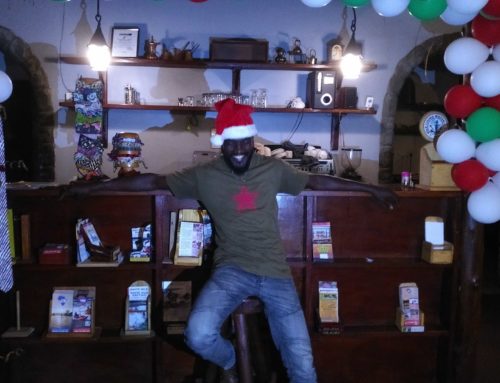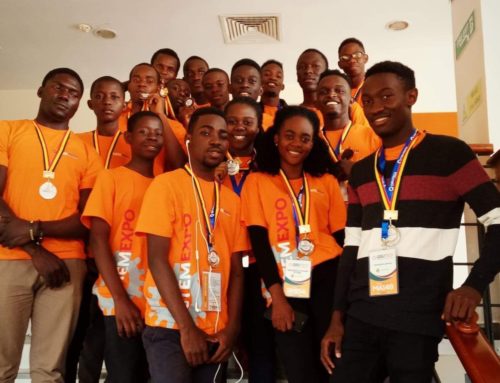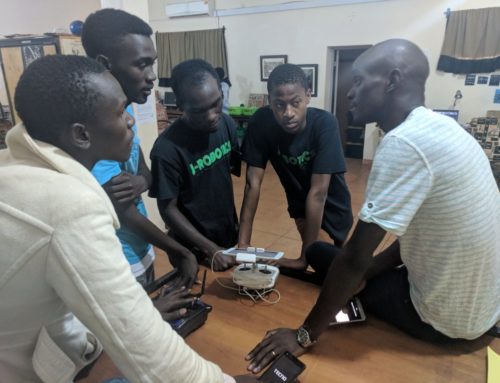Awesome news from the HFC Hackerspace, reported by Michelle from the Just Cause Uganda Blog.
We borrowed an amazing “Little Bits Workshop Kit” that Johnny, the Hackers for Charity founder had brought to the Hackerspace but that had not seen any action as of yet. This is a really simple snap-together magnetic kit that teaches kids to build many different concepts and inventions of their own. We were familiar with the product as we have used our own smaller kits many times for outreach days but this one was enough for a LOT of kids.
Together with the classroom teacher and our man-of-every-role Alex, we came up with some curriculum links that would reinforce prior learning and current learning for the students in their Science and Mathematics classes. Teacher John had told us that the technology component of the curriculum is something they only briefly talk about as there is no equipment and the concepts are beyond the kids since they have zero exposure out in this remote village. We all saw this as an opportunity to change that and we created a two hour session that introduced the concept of “what is a circuit”, input, output and control/sensors and their teacher made all kinds of links to their curriculum in the areas of body systems, feedback, reactions, motion, electricity, light and sound. He was terrific to work with as he caught on so quickly to how the technology worked and identified the areas it crossed over into his teaching. It was true collaboration between educators with different expertise and a great first time with team-teaching at Nanso.
The kids were very afraid at first to touch the equipment and just looked at the parts. This surprised us as usually we are trying to get students to hold on until all instructions are given so that they don’t break anything or they end up not really understanding what they are doing or how it works. It would really surprise you to see the lack of emotion and general confusion and legitimate fear from the kids as to what was happening because having hands on equipment has just absolutely never happened for these kids. We knew we would have to adjust our “open-ended” and “inquiry” model of teaching in this intro lesson as the school is very rote and very, very structured and that style of learning and teaching needs to happen gradually in this context. We wanted to work with the teachers and not impose ourselves and take the best of both and make something successful today. So after some group guidance and subtle gradual release of responsibility, we saw the students finally engage. Soon, there was a rainbow of lights and buzzers sounding and fans spinning and wheels turning all over the classroom and the initial fear and hesitation from the kids became intrigue and awe!
They were pretty quiet because they were mesmerized and most definitely engaged. It was just a very different reaction than working in a North American context with the very same equipment. The debrief with the teacher we worked with was very positive and eye opening and we really were impressed with how well he worked with us to make sure the students were understanding and connecting the activities and challenges we gave them to their classroom learning.
The spiders are no more and neither are the bats! We are very happy about the improvement to health and sanitation once more at the school and the students were very happy, especially the very little ones who were afraid of the corners of their classrooms. Before we departed, we had a staff meeting with the teachers and did an inventory of all of the school equipment. The teaching staff were overjoyed that we had managed to locate all but one of the curriculum documents and teaching guidebooks for the subjects and classes that were missing. Since there was no P7 before this year we were able to bring the full set of books for that as well as the PLE (Primary Leaving Examination) student preparation and review books. We also delivered the mandatory “Literacy 1-3” books to the lower years primary teachers which the government education inspector had demanded to see in the February inspection but that we did not have. So all is well at Nanso and we are pleased with the progress and how far they have come in improving the quality of the education of the children.
Our last bit of work will be an eye exam and getting proper glasses for the new teacher John, who is struggling so badly with his vision. He needs to be able to see to do his job and he is managing, but it is very difficult. We have an appointment to bring him in to a good eye doctor in Jinja and will be going ahead from there to see what we can do to help him.










